Effective Record Keeping and Reporting in Healthcare: IHG Analysis
VerifiedAdded on 2021/01/02
|13
|4175
|454
Report
AI Summary
This report analyzes healthcare record-keeping and reporting practices within the International Hospitals Group (IHG). It explores statutory requirements like GDPR and the Human Rights Act, as well as the role of regulatory bodies such as the CQC. The report examines the consequences of non-compliance, including impacts on service user safety, media perception, and the credibility of IHG. It delves into record storage methods, the rationale for information sharing, and the use of technology, such as CPR and EMR systems, to enhance efficiency and accuracy. The benefits of involving service users in record-keeping processes are also discussed. The report provides recommendations for improvement, emphasizing the importance of adherence to guidelines, staff training, and the adoption of secure, computer-based storage systems to ensure effective patient care, maintain confidentiality, and build trust among stakeholders. The report highlights the benefits of technology adoption in healthcare record keeping and reporting, while addressing the challenges and offering solutions for improved processes.
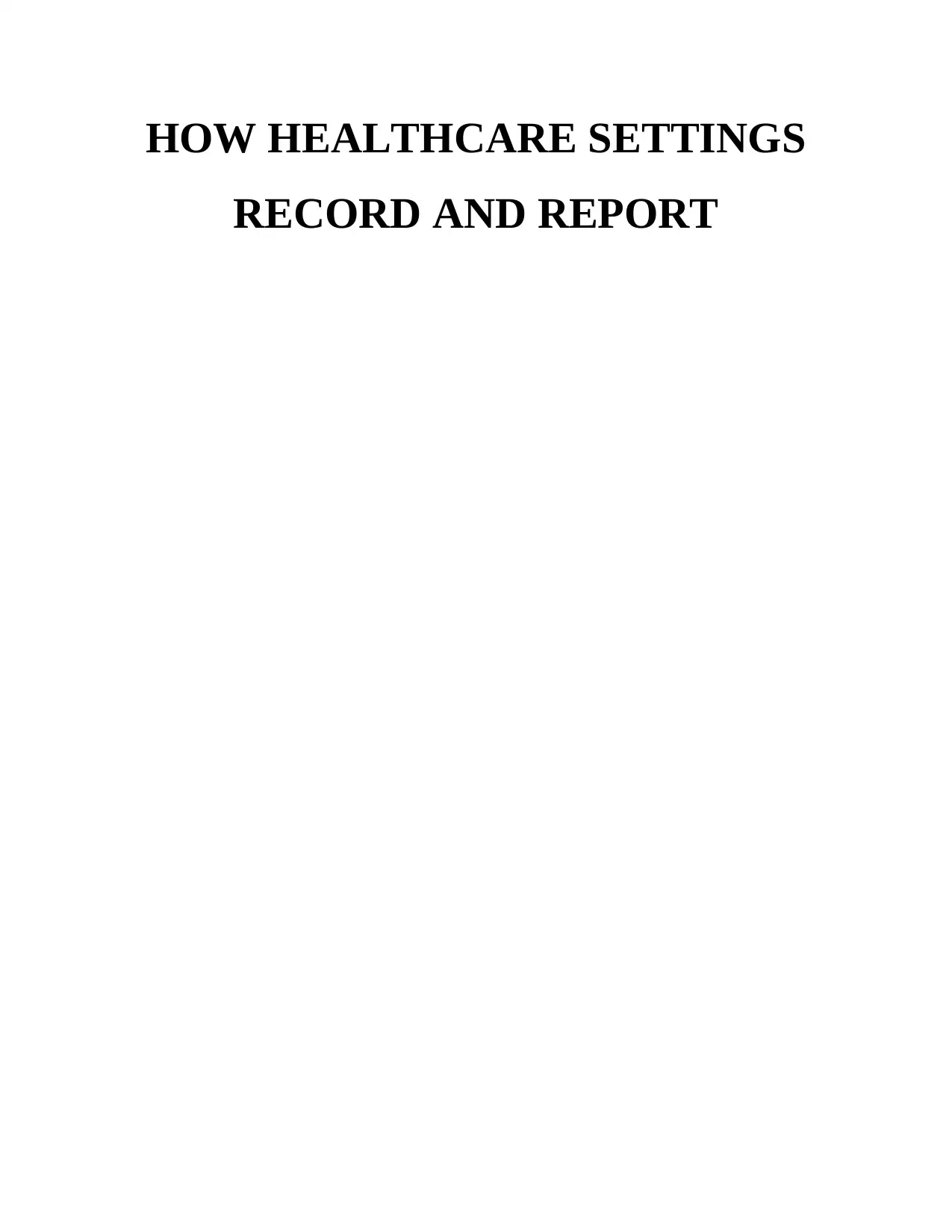
HOW HEALTHCARE SETTINGS
RECORD AND REPORT
RECORD AND REPORT
Paraphrase This Document
Need a fresh take? Get an instant paraphrase of this document with our AI Paraphraser
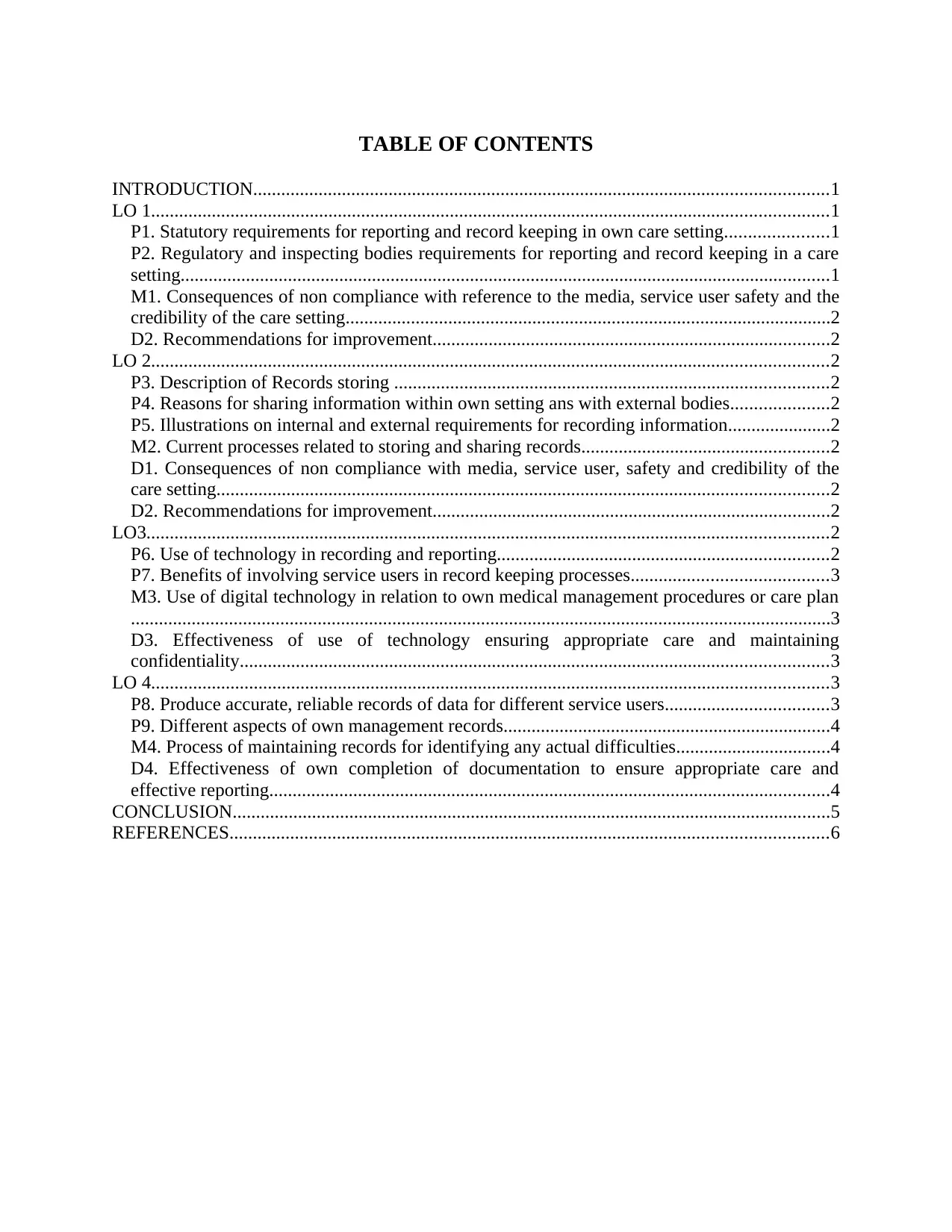
TABLE OF CONTENTS
INTRODUCTION...........................................................................................................................1
LO 1.................................................................................................................................................1
P1. Statutory requirements for reporting and record keeping in own care setting......................1
P2. Regulatory and inspecting bodies requirements for reporting and record keeping in a care
setting...........................................................................................................................................1
M1. Consequences of non compliance with reference to the media, service user safety and the
credibility of the care setting........................................................................................................2
D2. Recommendations for improvement.....................................................................................2
LO 2.................................................................................................................................................2
P3. Description of Records storing .............................................................................................2
P4. Reasons for sharing information within own setting ans with external bodies.....................2
P5. Illustrations on internal and external requirements for recording information......................2
M2. Current processes related to storing and sharing records.....................................................2
D1. Consequences of non compliance with media, service user, safety and credibility of the
care setting...................................................................................................................................2
D2. Recommendations for improvement.....................................................................................2
LO3..................................................................................................................................................2
P6. Use of technology in recording and reporting.......................................................................2
P7. Benefits of involving service users in record keeping processes..........................................3
M3. Use of digital technology in relation to own medical management procedures or care plan
......................................................................................................................................................3
D3. Effectiveness of use of technology ensuring appropriate care and maintaining
confidentiality..............................................................................................................................3
LO 4.................................................................................................................................................3
P8. Produce accurate, reliable records of data for different service users...................................3
P9. Different aspects of own management records......................................................................4
M4. Process of maintaining records for identifying any actual difficulties.................................4
D4. Effectiveness of own completion of documentation to ensure appropriate care and
effective reporting........................................................................................................................4
CONCLUSION................................................................................................................................5
REFERENCES................................................................................................................................6
INTRODUCTION...........................................................................................................................1
LO 1.................................................................................................................................................1
P1. Statutory requirements for reporting and record keeping in own care setting......................1
P2. Regulatory and inspecting bodies requirements for reporting and record keeping in a care
setting...........................................................................................................................................1
M1. Consequences of non compliance with reference to the media, service user safety and the
credibility of the care setting........................................................................................................2
D2. Recommendations for improvement.....................................................................................2
LO 2.................................................................................................................................................2
P3. Description of Records storing .............................................................................................2
P4. Reasons for sharing information within own setting ans with external bodies.....................2
P5. Illustrations on internal and external requirements for recording information......................2
M2. Current processes related to storing and sharing records.....................................................2
D1. Consequences of non compliance with media, service user, safety and credibility of the
care setting...................................................................................................................................2
D2. Recommendations for improvement.....................................................................................2
LO3..................................................................................................................................................2
P6. Use of technology in recording and reporting.......................................................................2
P7. Benefits of involving service users in record keeping processes..........................................3
M3. Use of digital technology in relation to own medical management procedures or care plan
......................................................................................................................................................3
D3. Effectiveness of use of technology ensuring appropriate care and maintaining
confidentiality..............................................................................................................................3
LO 4.................................................................................................................................................3
P8. Produce accurate, reliable records of data for different service users...................................3
P9. Different aspects of own management records......................................................................4
M4. Process of maintaining records for identifying any actual difficulties.................................4
D4. Effectiveness of own completion of documentation to ensure appropriate care and
effective reporting........................................................................................................................4
CONCLUSION................................................................................................................................5
REFERENCES................................................................................................................................6
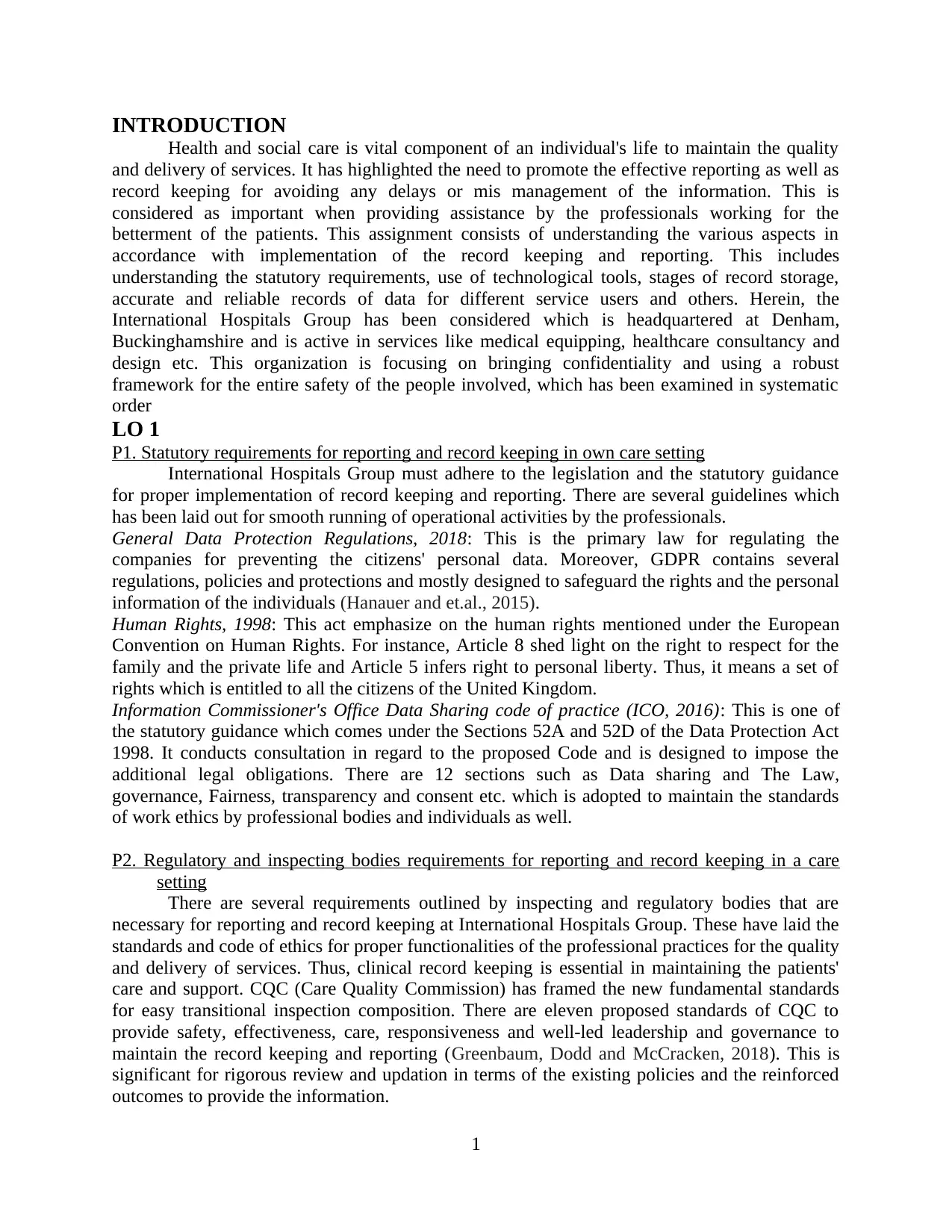
INTRODUCTION
Health and social care is vital component of an individual's life to maintain the quality
and delivery of services. It has highlighted the need to promote the effective reporting as well as
record keeping for avoiding any delays or mis management of the information. This is
considered as important when providing assistance by the professionals working for the
betterment of the patients. This assignment consists of understanding the various aspects in
accordance with implementation of the record keeping and reporting. This includes
understanding the statutory requirements, use of technological tools, stages of record storage,
accurate and reliable records of data for different service users and others. Herein, the
International Hospitals Group has been considered which is headquartered at Denham,
Buckinghamshire and is active in services like medical equipping, healthcare consultancy and
design etc. This organization is focusing on bringing confidentiality and using a robust
framework for the entire safety of the people involved, which has been examined in systematic
order
LO 1
P1. Statutory requirements for reporting and record keeping in own care setting
International Hospitals Group must adhere to the legislation and the statutory guidance
for proper implementation of record keeping and reporting. There are several guidelines which
has been laid out for smooth running of operational activities by the professionals.
General Data Protection Regulations, 2018: This is the primary law for regulating the
companies for preventing the citizens' personal data. Moreover, GDPR contains several
regulations, policies and protections and mostly designed to safeguard the rights and the personal
information of the individuals (Hanauer and et.al., 2015).
Human Rights, 1998: This act emphasize on the human rights mentioned under the European
Convention on Human Rights. For instance, Article 8 shed light on the right to respect for the
family and the private life and Article 5 infers right to personal liberty. Thus, it means a set of
rights which is entitled to all the citizens of the United Kingdom.
Information Commissioner's Office Data Sharing code of practice (ICO, 2016): This is one of
the statutory guidance which comes under the Sections 52A and 52D of the Data Protection Act
1998. It conducts consultation in regard to the proposed Code and is designed to impose the
additional legal obligations. There are 12 sections such as Data sharing and The Law,
governance, Fairness, transparency and consent etc. which is adopted to maintain the standards
of work ethics by professional bodies and individuals as well.
P2. Regulatory and inspecting bodies requirements for reporting and record keeping in a care
setting
There are several requirements outlined by inspecting and regulatory bodies that are
necessary for reporting and record keeping at International Hospitals Group. These have laid the
standards and code of ethics for proper functionalities of the professional practices for the quality
and delivery of services. Thus, clinical record keeping is essential in maintaining the patients'
care and support. CQC (Care Quality Commission) has framed the new fundamental standards
for easy transitional inspection composition. There are eleven proposed standards of CQC to
provide safety, effectiveness, care, responsiveness and well-led leadership and governance to
maintain the record keeping and reporting (Greenbaum, Dodd and McCracken, 2018). This is
significant for rigorous review and updation in terms of the existing policies and the reinforced
outcomes to provide the information.
1
Health and social care is vital component of an individual's life to maintain the quality
and delivery of services. It has highlighted the need to promote the effective reporting as well as
record keeping for avoiding any delays or mis management of the information. This is
considered as important when providing assistance by the professionals working for the
betterment of the patients. This assignment consists of understanding the various aspects in
accordance with implementation of the record keeping and reporting. This includes
understanding the statutory requirements, use of technological tools, stages of record storage,
accurate and reliable records of data for different service users and others. Herein, the
International Hospitals Group has been considered which is headquartered at Denham,
Buckinghamshire and is active in services like medical equipping, healthcare consultancy and
design etc. This organization is focusing on bringing confidentiality and using a robust
framework for the entire safety of the people involved, which has been examined in systematic
order
LO 1
P1. Statutory requirements for reporting and record keeping in own care setting
International Hospitals Group must adhere to the legislation and the statutory guidance
for proper implementation of record keeping and reporting. There are several guidelines which
has been laid out for smooth running of operational activities by the professionals.
General Data Protection Regulations, 2018: This is the primary law for regulating the
companies for preventing the citizens' personal data. Moreover, GDPR contains several
regulations, policies and protections and mostly designed to safeguard the rights and the personal
information of the individuals (Hanauer and et.al., 2015).
Human Rights, 1998: This act emphasize on the human rights mentioned under the European
Convention on Human Rights. For instance, Article 8 shed light on the right to respect for the
family and the private life and Article 5 infers right to personal liberty. Thus, it means a set of
rights which is entitled to all the citizens of the United Kingdom.
Information Commissioner's Office Data Sharing code of practice (ICO, 2016): This is one of
the statutory guidance which comes under the Sections 52A and 52D of the Data Protection Act
1998. It conducts consultation in regard to the proposed Code and is designed to impose the
additional legal obligations. There are 12 sections such as Data sharing and The Law,
governance, Fairness, transparency and consent etc. which is adopted to maintain the standards
of work ethics by professional bodies and individuals as well.
P2. Regulatory and inspecting bodies requirements for reporting and record keeping in a care
setting
There are several requirements outlined by inspecting and regulatory bodies that are
necessary for reporting and record keeping at International Hospitals Group. These have laid the
standards and code of ethics for proper functionalities of the professional practices for the quality
and delivery of services. Thus, clinical record keeping is essential in maintaining the patients'
care and support. CQC (Care Quality Commission) has framed the new fundamental standards
for easy transitional inspection composition. There are eleven proposed standards of CQC to
provide safety, effectiveness, care, responsiveness and well-led leadership and governance to
maintain the record keeping and reporting (Greenbaum, Dodd and McCracken, 2018). This is
significant for rigorous review and updation in terms of the existing policies and the reinforced
outcomes to provide the information.
1
⊘ This is a preview!⊘
Do you want full access?
Subscribe today to unlock all pages.

Trusted by 1+ million students worldwide
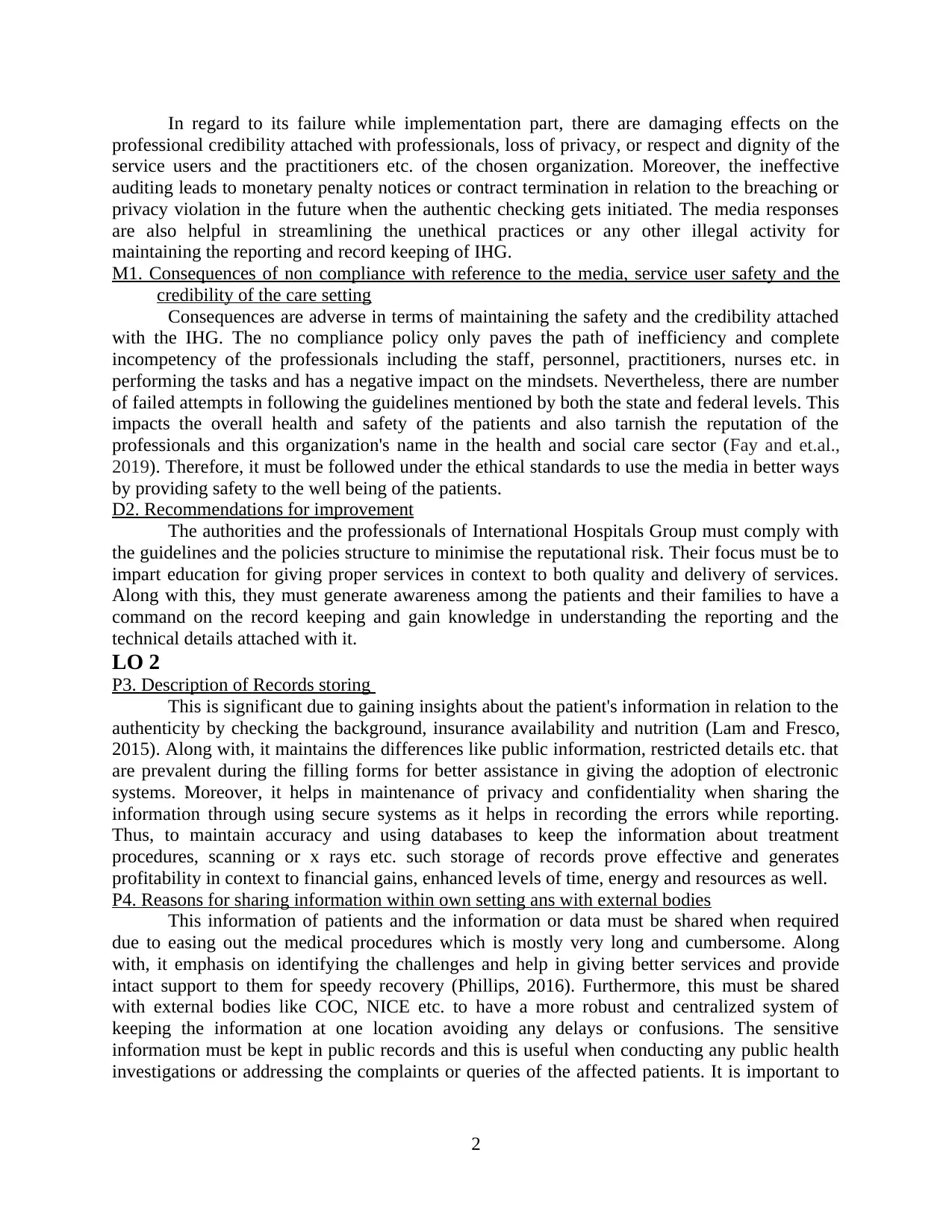
In regard to its failure while implementation part, there are damaging effects on the
professional credibility attached with professionals, loss of privacy, or respect and dignity of the
service users and the practitioners etc. of the chosen organization. Moreover, the ineffective
auditing leads to monetary penalty notices or contract termination in relation to the breaching or
privacy violation in the future when the authentic checking gets initiated. The media responses
are also helpful in streamlining the unethical practices or any other illegal activity for
maintaining the reporting and record keeping of IHG.
M1. Consequences of non compliance with reference to the media, service user safety and the
credibility of the care setting
Consequences are adverse in terms of maintaining the safety and the credibility attached
with the IHG. The no compliance policy only paves the path of inefficiency and complete
incompetency of the professionals including the staff, personnel, practitioners, nurses etc. in
performing the tasks and has a negative impact on the mindsets. Nevertheless, there are number
of failed attempts in following the guidelines mentioned by both the state and federal levels. This
impacts the overall health and safety of the patients and also tarnish the reputation of the
professionals and this organization's name in the health and social care sector (Fay and et.al.,
2019). Therefore, it must be followed under the ethical standards to use the media in better ways
by providing safety to the well being of the patients.
D2. Recommendations for improvement
The authorities and the professionals of International Hospitals Group must comply with
the guidelines and the policies structure to minimise the reputational risk. Their focus must be to
impart education for giving proper services in context to both quality and delivery of services.
Along with this, they must generate awareness among the patients and their families to have a
command on the record keeping and gain knowledge in understanding the reporting and the
technical details attached with it.
LO 2
P3. Description of Records storing
This is significant due to gaining insights about the patient's information in relation to the
authenticity by checking the background, insurance availability and nutrition (Lam and Fresco,
2015). Along with, it maintains the differences like public information, restricted details etc. that
are prevalent during the filling forms for better assistance in giving the adoption of electronic
systems. Moreover, it helps in maintenance of privacy and confidentiality when sharing the
information through using secure systems as it helps in recording the errors while reporting.
Thus, to maintain accuracy and using databases to keep the information about treatment
procedures, scanning or x rays etc. such storage of records prove effective and generates
profitability in context to financial gains, enhanced levels of time, energy and resources as well.
P4. Reasons for sharing information within own setting ans with external bodies
This information of patients and the information or data must be shared when required
due to easing out the medical procedures which is mostly very long and cumbersome. Along
with, it emphasis on identifying the challenges and help in giving better services and provide
intact support to them for speedy recovery (Phillips, 2016). Furthermore, this must be shared
with external bodies like COC, NICE etc. to have a more robust and centralized system of
keeping the information at one location avoiding any delays or confusions. The sensitive
information must be kept in public records and this is useful when conducting any public health
investigations or addressing the complaints or queries of the affected patients. It is important to
2
professional credibility attached with professionals, loss of privacy, or respect and dignity of the
service users and the practitioners etc. of the chosen organization. Moreover, the ineffective
auditing leads to monetary penalty notices or contract termination in relation to the breaching or
privacy violation in the future when the authentic checking gets initiated. The media responses
are also helpful in streamlining the unethical practices or any other illegal activity for
maintaining the reporting and record keeping of IHG.
M1. Consequences of non compliance with reference to the media, service user safety and the
credibility of the care setting
Consequences are adverse in terms of maintaining the safety and the credibility attached
with the IHG. The no compliance policy only paves the path of inefficiency and complete
incompetency of the professionals including the staff, personnel, practitioners, nurses etc. in
performing the tasks and has a negative impact on the mindsets. Nevertheless, there are number
of failed attempts in following the guidelines mentioned by both the state and federal levels. This
impacts the overall health and safety of the patients and also tarnish the reputation of the
professionals and this organization's name in the health and social care sector (Fay and et.al.,
2019). Therefore, it must be followed under the ethical standards to use the media in better ways
by providing safety to the well being of the patients.
D2. Recommendations for improvement
The authorities and the professionals of International Hospitals Group must comply with
the guidelines and the policies structure to minimise the reputational risk. Their focus must be to
impart education for giving proper services in context to both quality and delivery of services.
Along with this, they must generate awareness among the patients and their families to have a
command on the record keeping and gain knowledge in understanding the reporting and the
technical details attached with it.
LO 2
P3. Description of Records storing
This is significant due to gaining insights about the patient's information in relation to the
authenticity by checking the background, insurance availability and nutrition (Lam and Fresco,
2015). Along with, it maintains the differences like public information, restricted details etc. that
are prevalent during the filling forms for better assistance in giving the adoption of electronic
systems. Moreover, it helps in maintenance of privacy and confidentiality when sharing the
information through using secure systems as it helps in recording the errors while reporting.
Thus, to maintain accuracy and using databases to keep the information about treatment
procedures, scanning or x rays etc. such storage of records prove effective and generates
profitability in context to financial gains, enhanced levels of time, energy and resources as well.
P4. Reasons for sharing information within own setting ans with external bodies
This information of patients and the information or data must be shared when required
due to easing out the medical procedures which is mostly very long and cumbersome. Along
with, it emphasis on identifying the challenges and help in giving better services and provide
intact support to them for speedy recovery (Phillips, 2016). Furthermore, this must be shared
with external bodies like COC, NICE etc. to have a more robust and centralized system of
keeping the information at one location avoiding any delays or confusions. The sensitive
information must be kept in public records and this is useful when conducting any public health
investigations or addressing the complaints or queries of the affected patients. It is important to
2
Paraphrase This Document
Need a fresh take? Get an instant paraphrase of this document with our AI Paraphraser
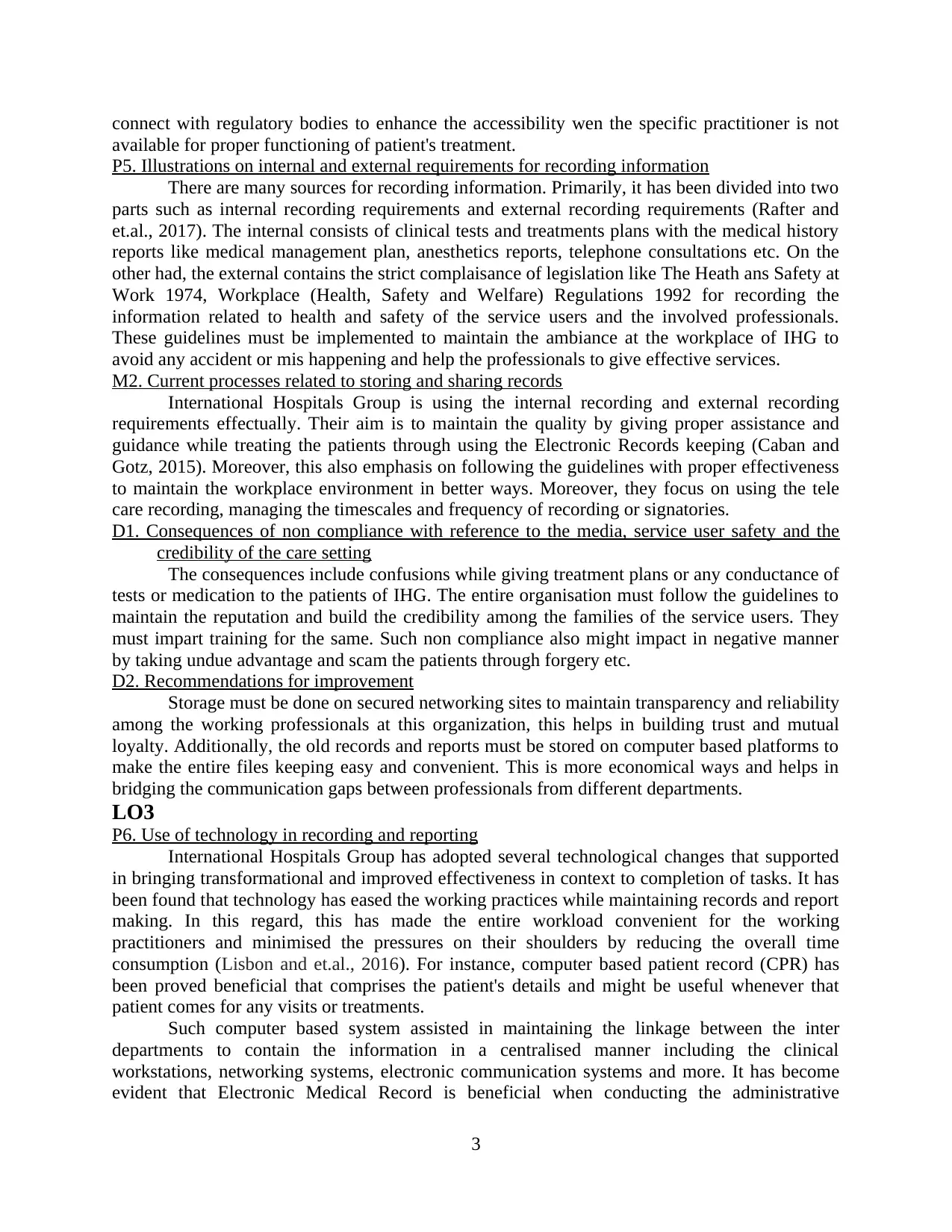
connect with regulatory bodies to enhance the accessibility wen the specific practitioner is not
available for proper functioning of patient's treatment.
P5. Illustrations on internal and external requirements for recording information
There are many sources for recording information. Primarily, it has been divided into two
parts such as internal recording requirements and external recording requirements (Rafter and
et.al., 2017). The internal consists of clinical tests and treatments plans with the medical history
reports like medical management plan, anesthetics reports, telephone consultations etc. On the
other had, the external contains the strict complaisance of legislation like The Heath ans Safety at
Work 1974, Workplace (Health, Safety and Welfare) Regulations 1992 for recording the
information related to health and safety of the service users and the involved professionals.
These guidelines must be implemented to maintain the ambiance at the workplace of IHG to
avoid any accident or mis happening and help the professionals to give effective services.
M2. Current processes related to storing and sharing records
International Hospitals Group is using the internal recording and external recording
requirements effectually. Their aim is to maintain the quality by giving proper assistance and
guidance while treating the patients through using the Electronic Records keeping (Caban and
Gotz, 2015). Moreover, this also emphasis on following the guidelines with proper effectiveness
to maintain the workplace environment in better ways. Moreover, they focus on using the tele
care recording, managing the timescales and frequency of recording or signatories.
D1. Consequences of non compliance with reference to the media, service user safety and the
credibility of the care setting
The consequences include confusions while giving treatment plans or any conductance of
tests or medication to the patients of IHG. The entire organisation must follow the guidelines to
maintain the reputation and build the credibility among the families of the service users. They
must impart training for the same. Such non compliance also might impact in negative manner
by taking undue advantage and scam the patients through forgery etc.
D2. Recommendations for improvement
Storage must be done on secured networking sites to maintain transparency and reliability
among the working professionals at this organization, this helps in building trust and mutual
loyalty. Additionally, the old records and reports must be stored on computer based platforms to
make the entire files keeping easy and convenient. This is more economical ways and helps in
bridging the communication gaps between professionals from different departments.
LO3
P6. Use of technology in recording and reporting
International Hospitals Group has adopted several technological changes that supported
in bringing transformational and improved effectiveness in context to completion of tasks. It has
been found that technology has eased the working practices while maintaining records and report
making. In this regard, this has made the entire workload convenient for the working
practitioners and minimised the pressures on their shoulders by reducing the overall time
consumption (Lisbon and et.al., 2016). For instance, computer based patient record (CPR) has
been proved beneficial that comprises the patient's details and might be useful whenever that
patient comes for any visits or treatments.
Such computer based system assisted in maintaining the linkage between the inter
departments to contain the information in a centralised manner including the clinical
workstations, networking systems, electronic communication systems and more. It has become
evident that Electronic Medical Record is beneficial when conducting the administrative
3
available for proper functioning of patient's treatment.
P5. Illustrations on internal and external requirements for recording information
There are many sources for recording information. Primarily, it has been divided into two
parts such as internal recording requirements and external recording requirements (Rafter and
et.al., 2017). The internal consists of clinical tests and treatments plans with the medical history
reports like medical management plan, anesthetics reports, telephone consultations etc. On the
other had, the external contains the strict complaisance of legislation like The Heath ans Safety at
Work 1974, Workplace (Health, Safety and Welfare) Regulations 1992 for recording the
information related to health and safety of the service users and the involved professionals.
These guidelines must be implemented to maintain the ambiance at the workplace of IHG to
avoid any accident or mis happening and help the professionals to give effective services.
M2. Current processes related to storing and sharing records
International Hospitals Group is using the internal recording and external recording
requirements effectually. Their aim is to maintain the quality by giving proper assistance and
guidance while treating the patients through using the Electronic Records keeping (Caban and
Gotz, 2015). Moreover, this also emphasis on following the guidelines with proper effectiveness
to maintain the workplace environment in better ways. Moreover, they focus on using the tele
care recording, managing the timescales and frequency of recording or signatories.
D1. Consequences of non compliance with reference to the media, service user safety and the
credibility of the care setting
The consequences include confusions while giving treatment plans or any conductance of
tests or medication to the patients of IHG. The entire organisation must follow the guidelines to
maintain the reputation and build the credibility among the families of the service users. They
must impart training for the same. Such non compliance also might impact in negative manner
by taking undue advantage and scam the patients through forgery etc.
D2. Recommendations for improvement
Storage must be done on secured networking sites to maintain transparency and reliability
among the working professionals at this organization, this helps in building trust and mutual
loyalty. Additionally, the old records and reports must be stored on computer based platforms to
make the entire files keeping easy and convenient. This is more economical ways and helps in
bridging the communication gaps between professionals from different departments.
LO3
P6. Use of technology in recording and reporting
International Hospitals Group has adopted several technological changes that supported
in bringing transformational and improved effectiveness in context to completion of tasks. It has
been found that technology has eased the working practices while maintaining records and report
making. In this regard, this has made the entire workload convenient for the working
practitioners and minimised the pressures on their shoulders by reducing the overall time
consumption (Lisbon and et.al., 2016). For instance, computer based patient record (CPR) has
been proved beneficial that comprises the patient's details and might be useful whenever that
patient comes for any visits or treatments.
Such computer based system assisted in maintaining the linkage between the inter
departments to contain the information in a centralised manner including the clinical
workstations, networking systems, electronic communication systems and more. It has become
evident that Electronic Medical Record is beneficial when conducting the administrative
3
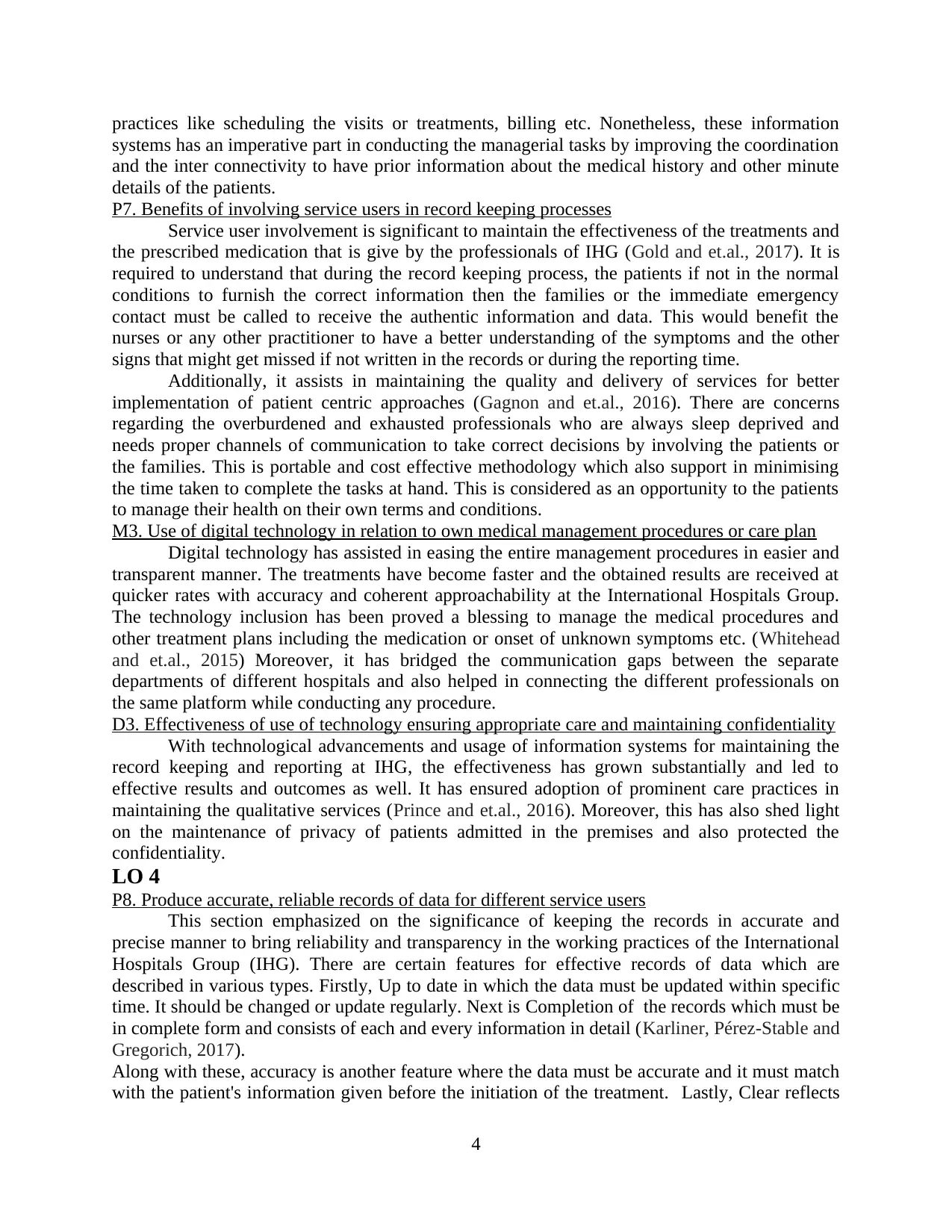
practices like scheduling the visits or treatments, billing etc. Nonetheless, these information
systems has an imperative part in conducting the managerial tasks by improving the coordination
and the inter connectivity to have prior information about the medical history and other minute
details of the patients.
P7. Benefits of involving service users in record keeping processes
Service user involvement is significant to maintain the effectiveness of the treatments and
the prescribed medication that is give by the professionals of IHG (Gold and et.al., 2017). It is
required to understand that during the record keeping process, the patients if not in the normal
conditions to furnish the correct information then the families or the immediate emergency
contact must be called to receive the authentic information and data. This would benefit the
nurses or any other practitioner to have a better understanding of the symptoms and the other
signs that might get missed if not written in the records or during the reporting time.
Additionally, it assists in maintaining the quality and delivery of services for better
implementation of patient centric approaches (Gagnon and et.al., 2016). There are concerns
regarding the overburdened and exhausted professionals who are always sleep deprived and
needs proper channels of communication to take correct decisions by involving the patients or
the families. This is portable and cost effective methodology which also support in minimising
the time taken to complete the tasks at hand. This is considered as an opportunity to the patients
to manage their health on their own terms and conditions.
M3. Use of digital technology in relation to own medical management procedures or care plan
Digital technology has assisted in easing the entire management procedures in easier and
transparent manner. The treatments have become faster and the obtained results are received at
quicker rates with accuracy and coherent approachability at the International Hospitals Group.
The technology inclusion has been proved a blessing to manage the medical procedures and
other treatment plans including the medication or onset of unknown symptoms etc. (Whitehead
and et.al., 2015) Moreover, it has bridged the communication gaps between the separate
departments of different hospitals and also helped in connecting the different professionals on
the same platform while conducting any procedure.
D3. Effectiveness of use of technology ensuring appropriate care and maintaining confidentiality
With technological advancements and usage of information systems for maintaining the
record keeping and reporting at IHG, the effectiveness has grown substantially and led to
effective results and outcomes as well. It has ensured adoption of prominent care practices in
maintaining the qualitative services (Prince and et.al., 2016). Moreover, this has also shed light
on the maintenance of privacy of patients admitted in the premises and also protected the
confidentiality.
LO 4
P8. Produce accurate, reliable records of data for different service users
This section emphasized on the significance of keeping the records in accurate and
precise manner to bring reliability and transparency in the working practices of the International
Hospitals Group (IHG). There are certain features for effective records of data which are
described in various types. Firstly, Up to date in which the data must be updated within specific
time. It should be changed or update regularly. Next is Completion of the records which must be
in complete form and consists of each and every information in detail (Karliner, Pérez-Stable and
Gregorich, 2017).
Along with these, accuracy is another feature where the data must be accurate and it must match
with the patient's information given before the initiation of the treatment. Lastly, Clear reflects
4
systems has an imperative part in conducting the managerial tasks by improving the coordination
and the inter connectivity to have prior information about the medical history and other minute
details of the patients.
P7. Benefits of involving service users in record keeping processes
Service user involvement is significant to maintain the effectiveness of the treatments and
the prescribed medication that is give by the professionals of IHG (Gold and et.al., 2017). It is
required to understand that during the record keeping process, the patients if not in the normal
conditions to furnish the correct information then the families or the immediate emergency
contact must be called to receive the authentic information and data. This would benefit the
nurses or any other practitioner to have a better understanding of the symptoms and the other
signs that might get missed if not written in the records or during the reporting time.
Additionally, it assists in maintaining the quality and delivery of services for better
implementation of patient centric approaches (Gagnon and et.al., 2016). There are concerns
regarding the overburdened and exhausted professionals who are always sleep deprived and
needs proper channels of communication to take correct decisions by involving the patients or
the families. This is portable and cost effective methodology which also support in minimising
the time taken to complete the tasks at hand. This is considered as an opportunity to the patients
to manage their health on their own terms and conditions.
M3. Use of digital technology in relation to own medical management procedures or care plan
Digital technology has assisted in easing the entire management procedures in easier and
transparent manner. The treatments have become faster and the obtained results are received at
quicker rates with accuracy and coherent approachability at the International Hospitals Group.
The technology inclusion has been proved a blessing to manage the medical procedures and
other treatment plans including the medication or onset of unknown symptoms etc. (Whitehead
and et.al., 2015) Moreover, it has bridged the communication gaps between the separate
departments of different hospitals and also helped in connecting the different professionals on
the same platform while conducting any procedure.
D3. Effectiveness of use of technology ensuring appropriate care and maintaining confidentiality
With technological advancements and usage of information systems for maintaining the
record keeping and reporting at IHG, the effectiveness has grown substantially and led to
effective results and outcomes as well. It has ensured adoption of prominent care practices in
maintaining the qualitative services (Prince and et.al., 2016). Moreover, this has also shed light
on the maintenance of privacy of patients admitted in the premises and also protected the
confidentiality.
LO 4
P8. Produce accurate, reliable records of data for different service users
This section emphasized on the significance of keeping the records in accurate and
precise manner to bring reliability and transparency in the working practices of the International
Hospitals Group (IHG). There are certain features for effective records of data which are
described in various types. Firstly, Up to date in which the data must be updated within specific
time. It should be changed or update regularly. Next is Completion of the records which must be
in complete form and consists of each and every information in detail (Karliner, Pérez-Stable and
Gregorich, 2017).
Along with these, accuracy is another feature where the data must be accurate and it must match
with the patient's information given before the initiation of the treatment. Lastly, Clear reflects
4
⊘ This is a preview!⊘
Do you want full access?
Subscribe today to unlock all pages.

Trusted by 1+ million students worldwide
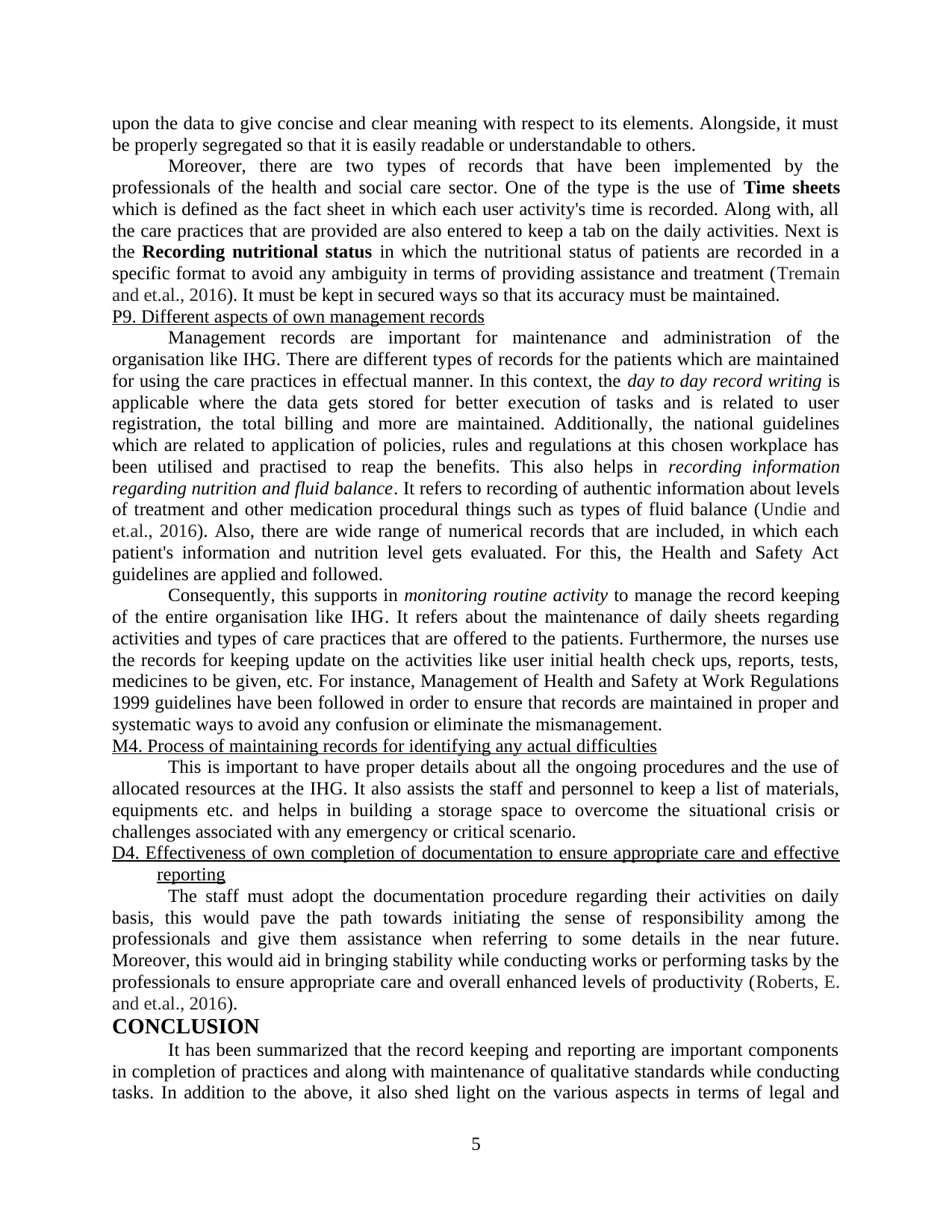
upon the data to give concise and clear meaning with respect to its elements. Alongside, it must
be properly segregated so that it is easily readable or understandable to others.
Moreover, there are two types of records that have been implemented by the
professionals of the health and social care sector. One of the type is the use of Time sheets
which is defined as the fact sheet in which each user activity's time is recorded. Along with, all
the care practices that are provided are also entered to keep a tab on the daily activities. Next is
the Recording nutritional status in which the nutritional status of patients are recorded in a
specific format to avoid any ambiguity in terms of providing assistance and treatment (Tremain
and et.al., 2016). It must be kept in secured ways so that its accuracy must be maintained.
P9. Different aspects of own management records
Management records are important for maintenance and administration of the
organisation like IHG. There are different types of records for the patients which are maintained
for using the care practices in effectual manner. In this context, the day to day record writing is
applicable where the data gets stored for better execution of tasks and is related to user
registration, the total billing and more are maintained. Additionally, the national guidelines
which are related to application of policies, rules and regulations at this chosen workplace has
been utilised and practised to reap the benefits. This also helps in recording information
regarding nutrition and fluid balance. It refers to recording of authentic information about levels
of treatment and other medication procedural things such as types of fluid balance (Undie and
et.al., 2016). Also, there are wide range of numerical records that are included, in which each
patient's information and nutrition level gets evaluated. For this, the Health and Safety Act
guidelines are applied and followed.
Consequently, this supports in monitoring routine activity to manage the record keeping
of the entire organisation like IHG. It refers about the maintenance of daily sheets regarding
activities and types of care practices that are offered to the patients. Furthermore, the nurses use
the records for keeping update on the activities like user initial health check ups, reports, tests,
medicines to be given, etc. For instance, Management of Health and Safety at Work Regulations
1999 guidelines have been followed in order to ensure that records are maintained in proper and
systematic ways to avoid any confusion or eliminate the mismanagement.
M4. Process of maintaining records for identifying any actual difficulties
This is important to have proper details about all the ongoing procedures and the use of
allocated resources at the IHG. It also assists the staff and personnel to keep a list of materials,
equipments etc. and helps in building a storage space to overcome the situational crisis or
challenges associated with any emergency or critical scenario.
D4. Effectiveness of own completion of documentation to ensure appropriate care and effective
reporting
The staff must adopt the documentation procedure regarding their activities on daily
basis, this would pave the path towards initiating the sense of responsibility among the
professionals and give them assistance when referring to some details in the near future.
Moreover, this would aid in bringing stability while conducting works or performing tasks by the
professionals to ensure appropriate care and overall enhanced levels of productivity (Roberts, E.
and et.al., 2016).
CONCLUSION
It has been summarized that the record keeping and reporting are important components
in completion of practices and along with maintenance of qualitative standards while conducting
tasks. In addition to the above, it also shed light on the various aspects in terms of legal and
5
be properly segregated so that it is easily readable or understandable to others.
Moreover, there are two types of records that have been implemented by the
professionals of the health and social care sector. One of the type is the use of Time sheets
which is defined as the fact sheet in which each user activity's time is recorded. Along with, all
the care practices that are provided are also entered to keep a tab on the daily activities. Next is
the Recording nutritional status in which the nutritional status of patients are recorded in a
specific format to avoid any ambiguity in terms of providing assistance and treatment (Tremain
and et.al., 2016). It must be kept in secured ways so that its accuracy must be maintained.
P9. Different aspects of own management records
Management records are important for maintenance and administration of the
organisation like IHG. There are different types of records for the patients which are maintained
for using the care practices in effectual manner. In this context, the day to day record writing is
applicable where the data gets stored for better execution of tasks and is related to user
registration, the total billing and more are maintained. Additionally, the national guidelines
which are related to application of policies, rules and regulations at this chosen workplace has
been utilised and practised to reap the benefits. This also helps in recording information
regarding nutrition and fluid balance. It refers to recording of authentic information about levels
of treatment and other medication procedural things such as types of fluid balance (Undie and
et.al., 2016). Also, there are wide range of numerical records that are included, in which each
patient's information and nutrition level gets evaluated. For this, the Health and Safety Act
guidelines are applied and followed.
Consequently, this supports in monitoring routine activity to manage the record keeping
of the entire organisation like IHG. It refers about the maintenance of daily sheets regarding
activities and types of care practices that are offered to the patients. Furthermore, the nurses use
the records for keeping update on the activities like user initial health check ups, reports, tests,
medicines to be given, etc. For instance, Management of Health and Safety at Work Regulations
1999 guidelines have been followed in order to ensure that records are maintained in proper and
systematic ways to avoid any confusion or eliminate the mismanagement.
M4. Process of maintaining records for identifying any actual difficulties
This is important to have proper details about all the ongoing procedures and the use of
allocated resources at the IHG. It also assists the staff and personnel to keep a list of materials,
equipments etc. and helps in building a storage space to overcome the situational crisis or
challenges associated with any emergency or critical scenario.
D4. Effectiveness of own completion of documentation to ensure appropriate care and effective
reporting
The staff must adopt the documentation procedure regarding their activities on daily
basis, this would pave the path towards initiating the sense of responsibility among the
professionals and give them assistance when referring to some details in the near future.
Moreover, this would aid in bringing stability while conducting works or performing tasks by the
professionals to ensure appropriate care and overall enhanced levels of productivity (Roberts, E.
and et.al., 2016).
CONCLUSION
It has been summarized that the record keeping and reporting are important components
in completion of practices and along with maintenance of qualitative standards while conducting
tasks. In addition to the above, it also shed light on the various aspects in terms of legal and
5
Paraphrase This Document
Need a fresh take? Get an instant paraphrase of this document with our AI Paraphraser
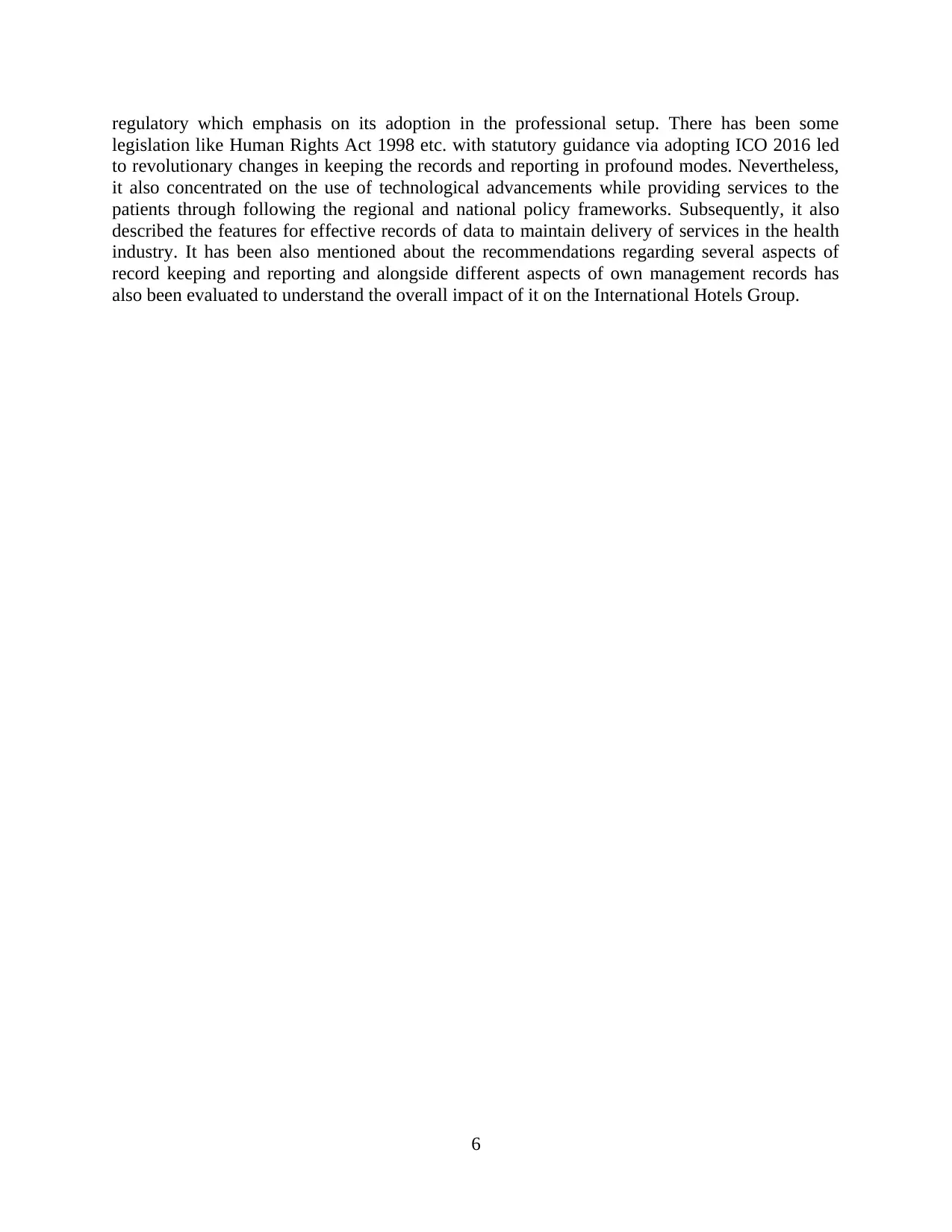
regulatory which emphasis on its adoption in the professional setup. There has been some
legislation like Human Rights Act 1998 etc. with statutory guidance via adopting ICO 2016 led
to revolutionary changes in keeping the records and reporting in profound modes. Nevertheless,
it also concentrated on the use of technological advancements while providing services to the
patients through following the regional and national policy frameworks. Subsequently, it also
described the features for effective records of data to maintain delivery of services in the health
industry. It has been also mentioned about the recommendations regarding several aspects of
record keeping and reporting and alongside different aspects of own management records has
also been evaluated to understand the overall impact of it on the International Hotels Group.
6
legislation like Human Rights Act 1998 etc. with statutory guidance via adopting ICO 2016 led
to revolutionary changes in keeping the records and reporting in profound modes. Nevertheless,
it also concentrated on the use of technological advancements while providing services to the
patients through following the regional and national policy frameworks. Subsequently, it also
described the features for effective records of data to maintain delivery of services in the health
industry. It has been also mentioned about the recommendations regarding several aspects of
record keeping and reporting and alongside different aspects of own management records has
also been evaluated to understand the overall impact of it on the International Hotels Group.
6
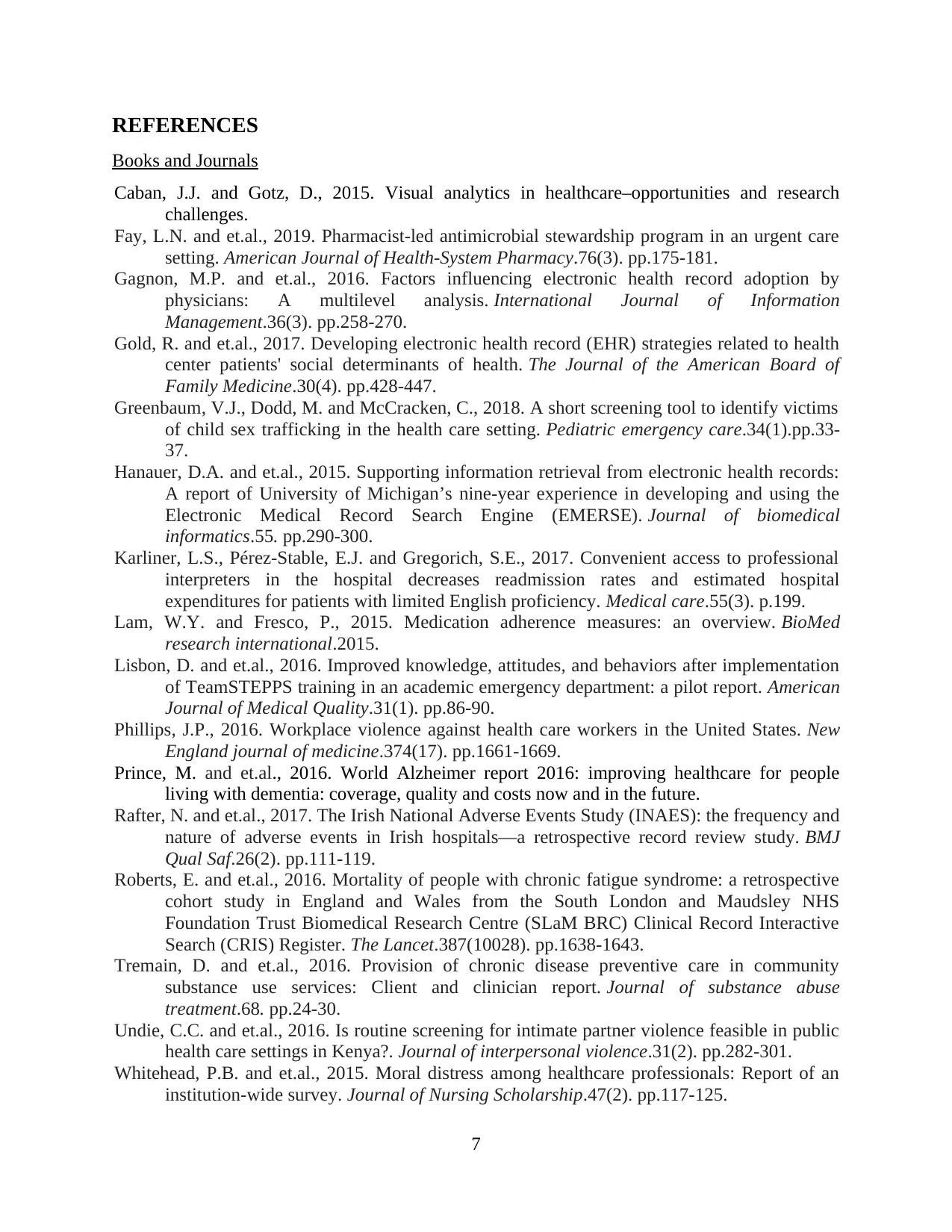
REFERENCES
Books and Journals
Caban, J.J. and Gotz, D., 2015. Visual analytics in healthcare–opportunities and research
challenges.
Fay, L.N. and et.al., 2019. Pharmacist-led antimicrobial stewardship program in an urgent care
setting. American Journal of Health-System Pharmacy.76(3). pp.175-181.
Gagnon, M.P. and et.al., 2016. Factors influencing electronic health record adoption by
physicians: A multilevel analysis. International Journal of Information
Management.36(3). pp.258-270.
Gold, R. and et.al., 2017. Developing electronic health record (EHR) strategies related to health
center patients' social determinants of health. The Journal of the American Board of
Family Medicine.30(4). pp.428-447.
Greenbaum, V.J., Dodd, M. and McCracken, C., 2018. A short screening tool to identify victims
of child sex trafficking in the health care setting. Pediatric emergency care.34(1).pp.33-
37.
Hanauer, D.A. and et.al., 2015. Supporting information retrieval from electronic health records:
A report of University of Michigan’s nine-year experience in developing and using the
Electronic Medical Record Search Engine (EMERSE). Journal of biomedical
informatics.55. pp.290-300.
Karliner, L.S., Pérez-Stable, E.J. and Gregorich, S.E., 2017. Convenient access to professional
interpreters in the hospital decreases readmission rates and estimated hospital
expenditures for patients with limited English proficiency. Medical care.55(3). p.199.
Lam, W.Y. and Fresco, P., 2015. Medication adherence measures: an overview. BioMed
research international.2015.
Lisbon, D. and et.al., 2016. Improved knowledge, attitudes, and behaviors after implementation
of TeamSTEPPS training in an academic emergency department: a pilot report. American
Journal of Medical Quality.31(1). pp.86-90.
Phillips, J.P., 2016. Workplace violence against health care workers in the United States. New
England journal of medicine.374(17). pp.1661-1669.
Prince, M. and et.al., 2016. World Alzheimer report 2016: improving healthcare for people
living with dementia: coverage, quality and costs now and in the future.
Rafter, N. and et.al., 2017. The Irish National Adverse Events Study (INAES): the frequency and
nature of adverse events in Irish hospitals—a retrospective record review study. BMJ
Qual Saf.26(2). pp.111-119.
Roberts, E. and et.al., 2016. Mortality of people with chronic fatigue syndrome: a retrospective
cohort study in England and Wales from the South London and Maudsley NHS
Foundation Trust Biomedical Research Centre (SLaM BRC) Clinical Record Interactive
Search (CRIS) Register. The Lancet.387(10028). pp.1638-1643.
Tremain, D. and et.al., 2016. Provision of chronic disease preventive care in community
substance use services: Client and clinician report. Journal of substance abuse
treatment.68. pp.24-30.
Undie, C.C. and et.al., 2016. Is routine screening for intimate partner violence feasible in public
health care settings in Kenya?. Journal of interpersonal violence.31(2). pp.282-301.
Whitehead, P.B. and et.al., 2015. Moral distress among healthcare professionals: Report of an
institution‐wide survey. Journal of Nursing Scholarship.47(2). pp.117-125.
7
Books and Journals
Caban, J.J. and Gotz, D., 2015. Visual analytics in healthcare–opportunities and research
challenges.
Fay, L.N. and et.al., 2019. Pharmacist-led antimicrobial stewardship program in an urgent care
setting. American Journal of Health-System Pharmacy.76(3). pp.175-181.
Gagnon, M.P. and et.al., 2016. Factors influencing electronic health record adoption by
physicians: A multilevel analysis. International Journal of Information
Management.36(3). pp.258-270.
Gold, R. and et.al., 2017. Developing electronic health record (EHR) strategies related to health
center patients' social determinants of health. The Journal of the American Board of
Family Medicine.30(4). pp.428-447.
Greenbaum, V.J., Dodd, M. and McCracken, C., 2018. A short screening tool to identify victims
of child sex trafficking in the health care setting. Pediatric emergency care.34(1).pp.33-
37.
Hanauer, D.A. and et.al., 2015. Supporting information retrieval from electronic health records:
A report of University of Michigan’s nine-year experience in developing and using the
Electronic Medical Record Search Engine (EMERSE). Journal of biomedical
informatics.55. pp.290-300.
Karliner, L.S., Pérez-Stable, E.J. and Gregorich, S.E., 2017. Convenient access to professional
interpreters in the hospital decreases readmission rates and estimated hospital
expenditures for patients with limited English proficiency. Medical care.55(3). p.199.
Lam, W.Y. and Fresco, P., 2015. Medication adherence measures: an overview. BioMed
research international.2015.
Lisbon, D. and et.al., 2016. Improved knowledge, attitudes, and behaviors after implementation
of TeamSTEPPS training in an academic emergency department: a pilot report. American
Journal of Medical Quality.31(1). pp.86-90.
Phillips, J.P., 2016. Workplace violence against health care workers in the United States. New
England journal of medicine.374(17). pp.1661-1669.
Prince, M. and et.al., 2016. World Alzheimer report 2016: improving healthcare for people
living with dementia: coverage, quality and costs now and in the future.
Rafter, N. and et.al., 2017. The Irish National Adverse Events Study (INAES): the frequency and
nature of adverse events in Irish hospitals—a retrospective record review study. BMJ
Qual Saf.26(2). pp.111-119.
Roberts, E. and et.al., 2016. Mortality of people with chronic fatigue syndrome: a retrospective
cohort study in England and Wales from the South London and Maudsley NHS
Foundation Trust Biomedical Research Centre (SLaM BRC) Clinical Record Interactive
Search (CRIS) Register. The Lancet.387(10028). pp.1638-1643.
Tremain, D. and et.al., 2016. Provision of chronic disease preventive care in community
substance use services: Client and clinician report. Journal of substance abuse
treatment.68. pp.24-30.
Undie, C.C. and et.al., 2016. Is routine screening for intimate partner violence feasible in public
health care settings in Kenya?. Journal of interpersonal violence.31(2). pp.282-301.
Whitehead, P.B. and et.al., 2015. Moral distress among healthcare professionals: Report of an
institution‐wide survey. Journal of Nursing Scholarship.47(2). pp.117-125.
7
⊘ This is a preview!⊘
Do you want full access?
Subscribe today to unlock all pages.

Trusted by 1+ million students worldwide

8
Paraphrase This Document
Need a fresh take? Get an instant paraphrase of this document with our AI Paraphraser

9

10
⊘ This is a preview!⊘
Do you want full access?
Subscribe today to unlock all pages.

Trusted by 1+ million students worldwide
1 out of 13
Related Documents
Your All-in-One AI-Powered Toolkit for Academic Success.
+13062052269
info@desklib.com
Available 24*7 on WhatsApp / Email
![[object Object]](/_next/static/media/star-bottom.7253800d.svg)
Unlock your academic potential
Copyright © 2020–2025 A2Z Services. All Rights Reserved. Developed and managed by ZUCOL.





